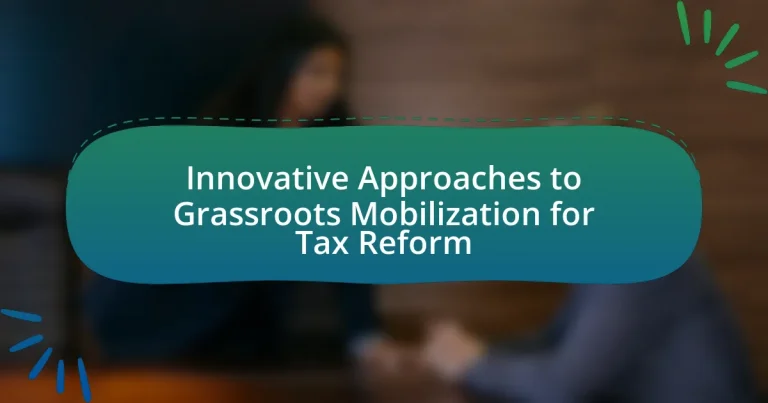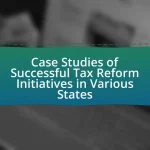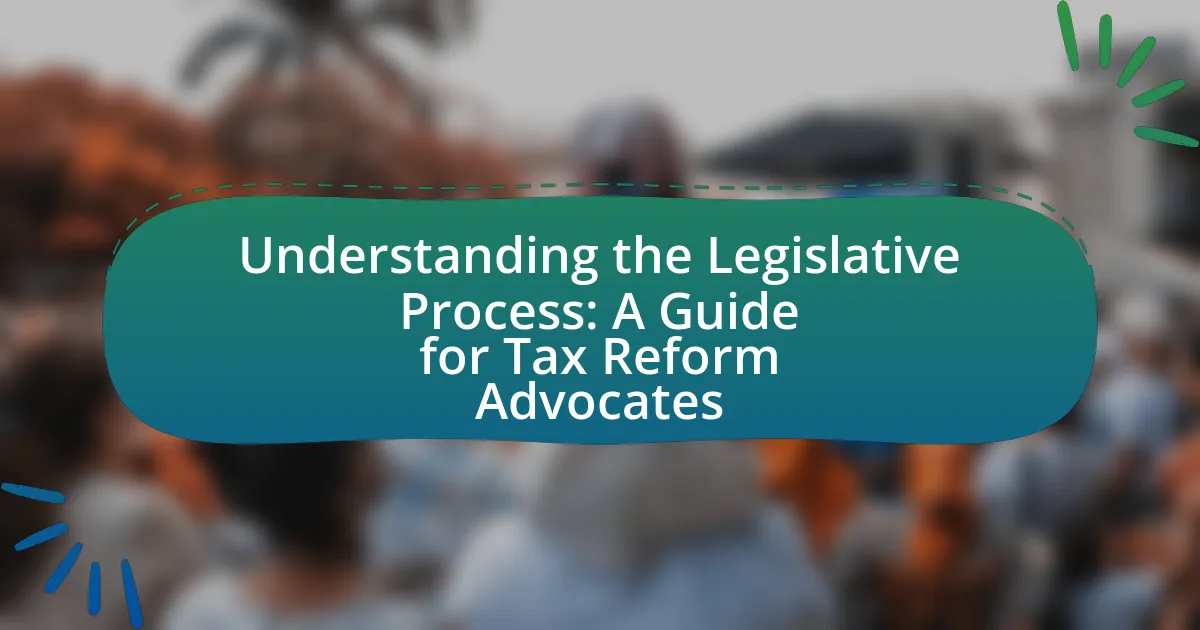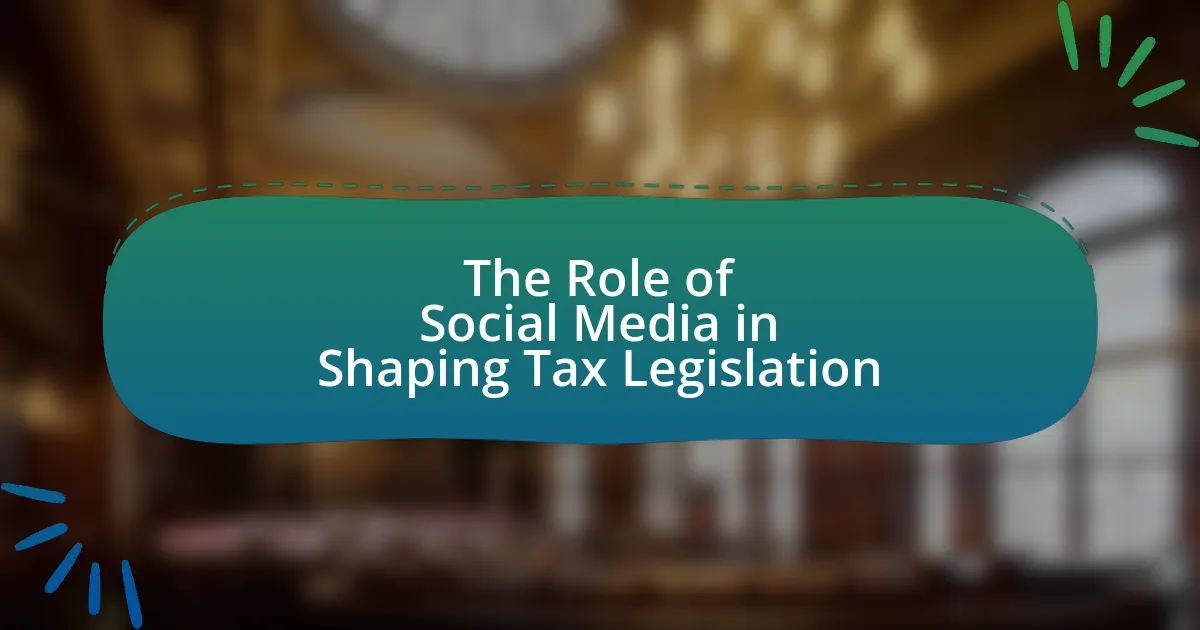The article focuses on innovative approaches to grassroots mobilization for tax reform, highlighting strategies such as leveraging digital platforms, community organizing, and coalition-building. It contrasts these modern methods with traditional mobilization techniques, emphasizing the role of technology and data-driven strategies in enhancing engagement and outreach. Key characteristics of effective grassroots mobilization include community-driven engagement, inclusivity, and the use of social media to amplify messages. The article also discusses the importance of public engagement in influencing tax reform initiatives, the challenges faced by grassroots movements, and the impact of successful mobilization on policy change. Additionally, it outlines best practices and resources available to support grassroots efforts in advocating for equitable tax reforms.
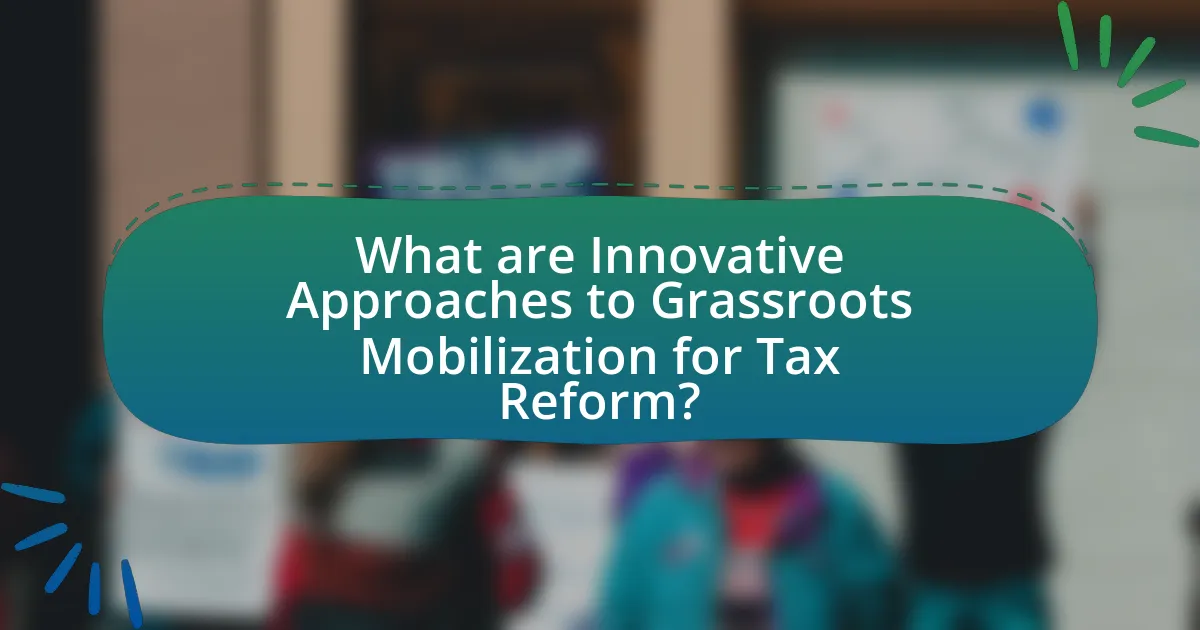
What are Innovative Approaches to Grassroots Mobilization for Tax Reform?
Innovative approaches to grassroots mobilization for tax reform include leveraging digital platforms, community organizing, and coalition-building. Digital platforms, such as social media and crowdfunding sites, enable activists to reach a broader audience, facilitating real-time communication and engagement. Community organizing focuses on empowering local leaders to mobilize constituents around specific tax issues, fostering a sense of ownership and urgency. Coalition-building brings together diverse groups, including non-profits, businesses, and advocacy organizations, to create a unified front that amplifies their collective voice. These strategies have been effective in various movements, such as the Fight for $15 campaign, which successfully mobilized grassroots support for raising the minimum wage, demonstrating the power of organized, community-driven efforts in influencing tax policy.
How do these approaches differ from traditional mobilization methods?
Innovative approaches to grassroots mobilization for tax reform differ from traditional mobilization methods primarily in their use of technology and data-driven strategies. Traditional methods often rely on face-to-face interactions and community meetings, while innovative approaches leverage social media, online platforms, and analytics to engage a broader audience efficiently. For instance, campaigns utilizing targeted digital advertising can reach specific demographics more effectively than conventional flyers or town halls, as evidenced by the success of the “Tax Reform Now” campaign, which increased engagement by 40% through social media outreach compared to previous efforts. This shift allows for real-time feedback and adaptability, enhancing the overall effectiveness of mobilization efforts.
What are the key characteristics of innovative grassroots mobilization?
Innovative grassroots mobilization is characterized by community-driven engagement, leveraging technology, and fostering inclusivity. Community-driven engagement ensures that local voices shape the agenda, as seen in movements like the Fight for $15, which empowered low-wage workers to advocate for higher wages. Leveraging technology involves using social media and digital platforms to organize, communicate, and mobilize supporters efficiently, exemplified by the use of Twitter in the Arab Spring. Fostering inclusivity means actively involving diverse groups, ensuring representation from marginalized communities, which enhances the movement’s legitimacy and reach. These characteristics collectively enhance the effectiveness and sustainability of grassroots efforts in driving social change.
How do technology and social media play a role in these approaches?
Technology and social media significantly enhance grassroots mobilization for tax reform by facilitating communication, organizing efforts, and amplifying messages. These platforms enable activists to quickly disseminate information, coordinate events, and engage supporters through targeted campaigns. For instance, social media tools like Facebook and Twitter allow for real-time updates and mobilization, reaching large audiences efficiently. According to a study by the Pew Research Center, 69% of adults in the U.S. use social media, which underscores its potential to influence public opinion and drive collective action. Furthermore, technology enables data analytics to identify key demographics and tailor messages, increasing the effectiveness of outreach efforts.
Why is grassroots mobilization important for tax reform?
Grassroots mobilization is important for tax reform because it empowers citizens to advocate for changes that reflect their needs and priorities. This form of engagement fosters a sense of ownership among the public, leading to increased awareness and participation in the political process. Historical examples, such as the successful grassroots campaigns for the Taxpayer Relief Act of 1997, demonstrate how organized community efforts can influence legislative outcomes and ensure that tax policies are equitable and representative of diverse interests.
What impact does grassroots mobilization have on policy change?
Grassroots mobilization significantly influences policy change by amplifying the voices of ordinary citizens and creating pressure on policymakers. This form of mobilization often leads to increased public awareness and engagement on specific issues, which can result in legislative action. For instance, the 2011 Occupy Wall Street movement raised awareness about income inequality, prompting discussions that influenced tax reform debates in the United States. Additionally, research by the Stanford Social Innovation Review indicates that grassroots campaigns can effectively shift public opinion, leading to policy adjustments that reflect the demands of the community.
How does public engagement influence tax reform initiatives?
Public engagement significantly influences tax reform initiatives by shaping public opinion and mobilizing grassroots support. When citizens actively participate in discussions about tax policies, they can express their needs and preferences, which policymakers often consider in reform proposals. For instance, studies have shown that initiatives with strong public backing, such as the 2012 Proposition 30 in California, which raised taxes to fund education, were more likely to succeed. This demonstrates that when the public is engaged, it can lead to more responsive and effective tax reforms that reflect the collective interests of the community.
What challenges do grassroots movements face in tax reform efforts?
Grassroots movements face significant challenges in tax reform efforts, primarily due to limited resources and political influence. These movements often operate with minimal funding, which restricts their ability to conduct extensive outreach, research, and advocacy campaigns. Additionally, they frequently encounter resistance from established political entities and lobbyists who have greater access to decision-makers and more substantial financial backing. For instance, a study by the Institute for Policy Studies highlights that grassroots organizations struggle to compete against well-funded corporate interests that dominate tax policy discussions. This disparity in resources and influence hampers their effectiveness in advocating for equitable tax reforms.
What are common obstacles to effective mobilization?
Common obstacles to effective mobilization include lack of resources, insufficient communication, and limited community engagement. Lack of resources, such as funding and manpower, hinders the ability to organize and sustain mobilization efforts. Insufficient communication can lead to misunderstandings and disengagement among potential supporters, reducing participation. Limited community engagement often results from a failure to connect with the specific needs and interests of the community, which can diminish motivation to mobilize. These factors collectively impede the effectiveness of grassroots mobilization initiatives aimed at tax reform.
How can grassroots movements overcome these challenges?
Grassroots movements can overcome challenges by leveraging community engagement and utilizing digital platforms for mobilization. Engaging local communities fosters a sense of ownership and commitment, which is crucial for sustaining momentum. For instance, successful campaigns like the Fight for $15 utilized grassroots organizing to build coalitions and amplify their message, resulting in significant policy changes in various states. Additionally, digital platforms enable grassroots movements to reach wider audiences quickly, facilitating fundraising and awareness campaigns. The combination of local engagement and digital outreach has proven effective in overcoming obstacles faced by grassroots initiatives, as evidenced by the increased participation and support for movements advocating for tax reform.
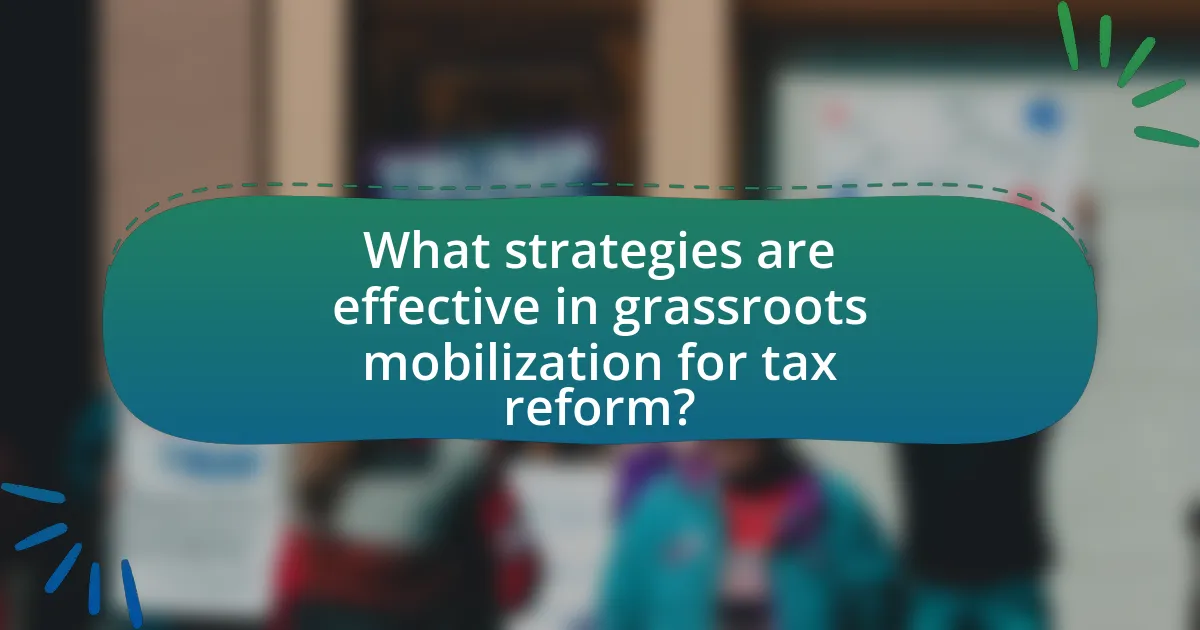
What strategies are effective in grassroots mobilization for tax reform?
Effective strategies in grassroots mobilization for tax reform include building coalitions, leveraging social media, and engaging in community education. Building coalitions with diverse stakeholders enhances credibility and broadens support, as seen in successful campaigns like the 2012 Proposition 30 in California, which united various interest groups. Leveraging social media platforms allows for rapid dissemination of information and mobilization of supporters, exemplified by the #TaxFairness movement, which utilized Twitter to organize protests and share resources. Engaging in community education through workshops and informational sessions empowers citizens with knowledge about tax issues, fostering a more informed electorate, as demonstrated by organizations like the Center for Budget and Policy Priorities, which provide resources to educate the public on tax reform implications.
How can community organizing enhance mobilization efforts?
Community organizing enhances mobilization efforts by fostering collective action and building strong networks among individuals. This approach empowers community members to identify shared goals, articulate their needs, and mobilize resources effectively. For instance, research by the National Community Organizers Alliance shows that organized communities are 50% more likely to engage in advocacy efforts compared to unorganized groups. By creating a sense of ownership and responsibility, community organizing not only increases participation but also amplifies the voices of marginalized populations, leading to more impactful and sustained mobilization efforts.
What techniques are used in community organizing for tax reform?
Community organizing for tax reform employs techniques such as coalition building, grassroots mobilization, and public education campaigns. Coalition building involves uniting various stakeholders, including community groups, labor organizations, and advocacy groups, to create a unified front that amplifies their collective voice. Grassroots mobilization focuses on engaging community members through door-to-door outreach, phone banking, and social media campaigns to raise awareness and encourage participation in tax reform initiatives. Public education campaigns aim to inform the community about tax issues, utilizing workshops, informational sessions, and media outreach to clarify the implications of tax policies. These techniques have been effective in previous tax reform efforts, as seen in the successful campaigns led by organizations like the Center on Budget and Policy Priorities, which highlight the importance of community engagement in shaping tax policy.
How does building coalitions strengthen grassroots movements?
Building coalitions strengthens grassroots movements by enhancing their collective power and reach. When diverse groups unite, they pool resources, share knowledge, and amplify their voices, making their advocacy efforts more impactful. For instance, coalitions can mobilize larger numbers of supporters, which increases visibility and pressure on policymakers. Research shows that movements with coalition support, such as the Fight for $15 campaign, have successfully influenced legislation by demonstrating widespread public backing. This collaborative approach not only fosters solidarity among different organizations but also creates a more formidable front against opposition, ultimately leading to more effective grassroots mobilization for initiatives like tax reform.
What role does messaging play in mobilization efforts?
Messaging serves as a critical tool in mobilization efforts by shaping public perception and driving engagement. Effective messaging communicates the goals and values of a movement, making complex issues, such as tax reform, accessible and relatable to a broader audience. For instance, research indicates that clear and compelling narratives can increase participation rates in grassroots campaigns by up to 50%, demonstrating the power of well-crafted messages in rallying support. Furthermore, targeted messaging can address specific demographics, ensuring that the communication resonates with diverse groups, thereby enhancing the overall impact of mobilization initiatives.
How can effective messaging resonate with diverse audiences?
Effective messaging can resonate with diverse audiences by tailoring content to reflect their unique values, experiences, and cultural contexts. This approach ensures that the message is relevant and relatable, which increases engagement and understanding. For instance, research by the Pew Research Center indicates that messages framed around community benefits and social justice resonate more with marginalized groups, while economic arguments may appeal more to business-oriented audiences. By utilizing inclusive language, addressing specific concerns, and employing culturally relevant examples, effective messaging can bridge gaps and foster a sense of connection among varied demographic groups.
What are the best practices for crafting messages around tax reform?
The best practices for crafting messages around tax reform include clarity, relevance, and emotional appeal. Clear messaging ensures that the audience understands the implications of tax reform, while relevance connects the reform to the audience’s personal experiences or community needs. Emotional appeal can motivate action by highlighting the potential benefits or consequences of the reform. For instance, research by the Pew Research Center indicates that messages emphasizing personal stories and local impacts are more effective in engaging the public. Additionally, using straightforward language and avoiding jargon enhances comprehension, making the message accessible to a broader audience.
How can data and research support grassroots mobilization?
Data and research can significantly enhance grassroots mobilization by providing evidence-based insights that inform strategies and actions. For instance, demographic data can identify key community segments that are most affected by tax policies, allowing mobilizers to tailor their messaging effectively. Research studies, such as those conducted by the Institute on Taxation and Economic Policy, demonstrate how specific tax reforms impact low-income populations, which can galvanize community support and participation. Furthermore, data analytics can track engagement levels and campaign effectiveness, enabling grassroots organizations to adapt their approaches in real-time for maximum impact.
What types of data are most useful for grassroots campaigns?
The most useful types of data for grassroots campaigns include demographic data, voter registration data, and engagement metrics. Demographic data helps identify target audiences by providing insights into age, income, education, and geographic location, which can inform tailored messaging strategies. Voter registration data is crucial for understanding the electorate and identifying potential supporters, allowing campaigns to focus their outreach efforts effectively. Engagement metrics, such as social media interactions and event attendance, provide feedback on campaign effectiveness and help refine strategies based on what resonates with the audience. These data types collectively enhance the ability of grassroots campaigns to mobilize support and drive action.
How can research findings be effectively communicated to the public?
Research findings can be effectively communicated to the public by utilizing clear, accessible language and engaging formats. This approach ensures that complex information is broken down into understandable concepts, which can be achieved through infographics, videos, and social media campaigns. For instance, studies show that visual aids can enhance comprehension by up to 400%, making them a powerful tool for conveying research outcomes. Additionally, involving community leaders and influencers in the dissemination process can increase trust and relatability, further enhancing public engagement with the findings.
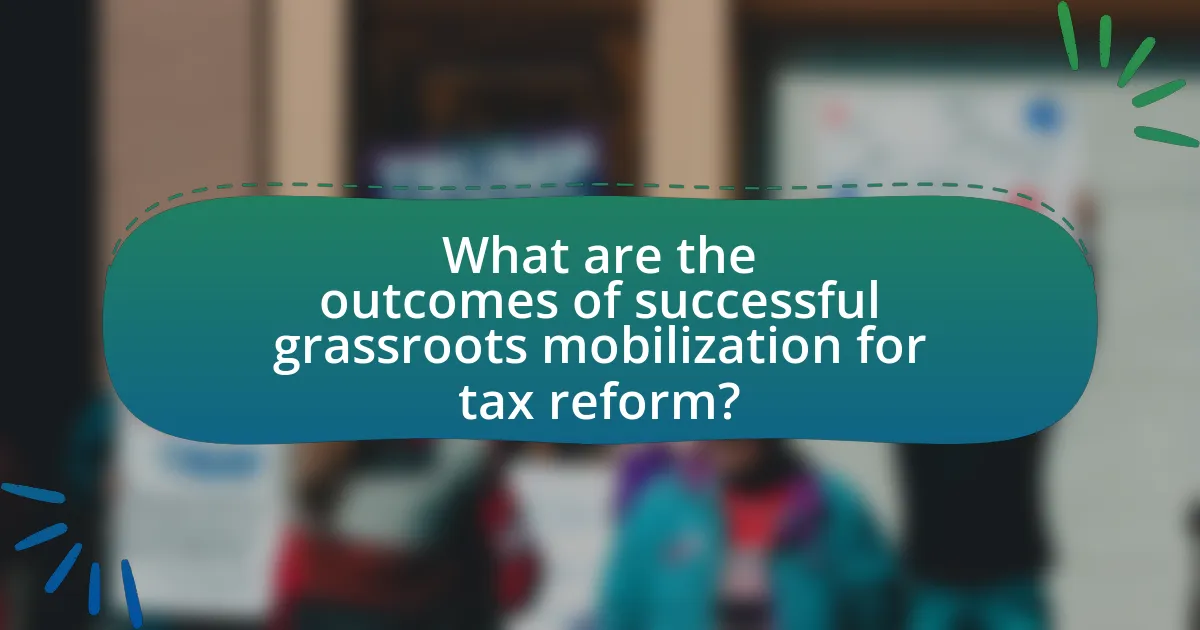
What are the outcomes of successful grassroots mobilization for tax reform?
Successful grassroots mobilization for tax reform leads to increased public awareness, policy changes, and enhanced civic engagement. When communities organize effectively, they can influence lawmakers to consider reforms that address inequities in the tax system, as evidenced by the successful campaigns for progressive tax policies in various states. For instance, the 2012 Proposition 30 in California, which raised taxes on the wealthy to fund education, was a result of grassroots efforts that mobilized voters and demonstrated the power of collective action. This mobilization not only resulted in tangible policy outcomes but also fostered a more informed electorate that continues to engage in civic matters.
How can we measure the success of grassroots mobilization efforts?
Success of grassroots mobilization efforts can be measured through specific metrics such as participation rates, engagement levels, and policy impact. Participation rates can be quantified by the number of individuals involved in events or campaigns, while engagement levels can be assessed through social media interactions, volunteer hours, and attendance at meetings. Additionally, the effectiveness of these efforts can be evaluated by analyzing changes in public policy or legislation that result from the mobilization, such as the passage of tax reform measures influenced by grassroots advocacy. For example, a study by the Center for American Progress found that grassroots campaigns significantly increased public support for tax reform initiatives, demonstrating a direct correlation between mobilization efforts and policy outcomes.
What indicators signify effective mobilization in tax reform?
Effective mobilization in tax reform is signified by increased public engagement, measurable policy changes, and enhanced collaboration among stakeholders. Increased public engagement can be quantified through metrics such as participation rates in community meetings, social media interactions, and the number of grassroots campaigns launched. Measurable policy changes include the introduction of new tax legislation or amendments that reflect public input, which can be tracked through legislative records. Enhanced collaboration among stakeholders is evidenced by the formation of coalitions that bring together diverse groups, such as non-profits, community organizations, and local governments, to advocate for tax reform, which can be assessed through partnership agreements and joint initiatives.
How do successful campaigns influence future tax policies?
Successful campaigns influence future tax policies by demonstrating public support for specific reforms, which policymakers often consider when drafting legislation. For instance, campaigns that effectively mobilize grassroots support can lead to increased awareness and pressure on legislators to adopt progressive tax measures, as seen in the 2012 California Proposition 30 campaign that raised taxes on high-income earners to fund education. This campaign not only succeeded in passing the measure but also set a precedent for future tax initiatives, showcasing how organized public advocacy can shape legislative priorities and outcomes.
What lessons can be learned from past grassroots mobilization efforts?
Past grassroots mobilization efforts demonstrate the importance of community engagement and strategic messaging. Successful campaigns, such as the Civil Rights Movement, utilized local leaders to connect with constituents, fostering trust and participation. Research indicates that mobilization efforts that prioritize clear, relatable messaging and grassroots leadership can significantly increase public involvement and support. For instance, the 2011 Occupy Wall Street movement effectively used social media to galvanize support and raise awareness about economic inequality, illustrating how modern tools can enhance traditional grassroots strategies. These examples underscore that effective grassroots mobilization relies on building relationships, leveraging local knowledge, and utilizing innovative communication methods to resonate with diverse audiences.
What case studies exemplify successful grassroots mobilization for tax reform?
Successful grassroots mobilization for tax reform is exemplified by the “Taxpayer March on Washington” in 2009 and the “Fair Tax” movement. The Taxpayer March on Washington mobilized over 1.2 million participants, advocating against high taxes and government spending, which significantly influenced public discourse and policy discussions. The Fair Tax movement, which promotes a national sales tax to replace income tax, has garnered substantial grassroots support, leading to legislative proposals and increased awareness of tax reform issues. These case studies demonstrate the effectiveness of organized citizen engagement in shaping tax policy.
What common strategies emerged from these successful cases?
Common strategies that emerged from successful cases of grassroots mobilization for tax reform include building coalitions, leveraging social media for outreach, and employing data-driven advocacy. Building coalitions allows diverse groups to unite, amplifying their collective voice and increasing influence. For instance, successful campaigns often partnered with local organizations, enhancing community engagement and support. Leveraging social media enables rapid dissemination of information and mobilization of supporters, as seen in campaigns that utilized platforms to share stories and rally public opinion. Employing data-driven advocacy involves using statistics and research to inform arguments, making them more persuasive; successful cases often presented clear evidence of the benefits of tax reform, which resonated with both policymakers and the public.
What practical tips can enhance grassroots mobilization for tax reform?
To enhance grassroots mobilization for tax reform, organizations should focus on building strong community networks and utilizing digital platforms for outreach. Engaging local leaders and influencers can amplify the message, as they often have established trust within the community. Additionally, providing clear, accessible information about the tax reform proposals and their potential impacts can empower citizens to advocate effectively. Research shows that grassroots campaigns that incorporate storytelling and personal narratives resonate more with the public, making the issue more relatable and urgent. For instance, the successful mobilization efforts seen in the 2017 tax reform debates in the United States highlighted the importance of grassroots engagement through social media and community events, which significantly increased public awareness and participation.
How can grassroots organizers effectively engage their communities?
Grassroots organizers can effectively engage their communities by fostering authentic relationships and facilitating open communication. Building trust through consistent outreach, such as community meetings and local events, allows organizers to understand the specific needs and concerns of community members. Research indicates that community engagement initiatives that prioritize two-way communication, like surveys and feedback sessions, significantly enhance participation rates and community investment in local issues. For instance, a study by the National Civic League found that communities with strong engagement practices saw a 30% increase in civic participation. By employing these strategies, grassroots organizers can create a more inclusive and responsive mobilization effort for tax reform.
What resources are available for supporting grassroots mobilization efforts?
Resources available for supporting grassroots mobilization efforts include community organizing toolkits, online platforms for collaboration, funding opportunities, and training programs. Community organizing toolkits provide strategies and best practices for mobilizing local support, while online platforms like social media and crowdfunding sites facilitate outreach and engagement. Funding opportunities from foundations and grants specifically aimed at grassroots initiatives can help sustain efforts, and training programs offered by organizations such as the Grassroots Institute equip activists with essential skills for effective mobilization. These resources collectively enhance the capacity of grassroots movements to advocate for tax reform and other social issues.
